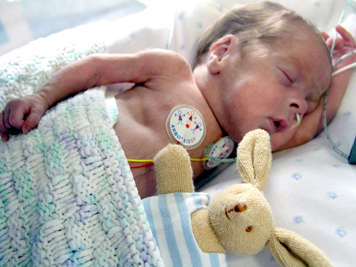Pain in premature babies is treated in much the same way as in older children and adults. Medications and behavioural and physical methods are all used. Often, parents can participate in the behavioural and physical methods of pain relief. These are discussed further down this page.

Pain medications
Depending on their condition and the amount of pain present, premature babies may be given acetaminophen (Tylenol) or stronger medications such as morphine or fentanyl. These medications act on the body as a whole.
Premature babies may also be given local anesthetics, drugs that act only where they are applied on the body. These include EMLA and ametop, which are creams applied to the skin.
Although technically sedatives are not pain relief medications, a premature baby may be sedated in the NICU. Premature babies may be sedated if they are to undergo a procedure in which they must remain still, such as an X-ray. Premature babies may also be sedated if they are having trouble adjusting to the rhythms of a ventilator. Common sedative drugs include phenobarbital and midazolam.
Premature babies may also be given sucrose as a pain reliever. Studies have shown that a baby’s pain can be relieved when they suck on a pacifier dipped in sucrose, although how and why this happens is not well understood.
Drug safety and addiction
Many parents are concerned about their children being prescribed strong opioids such as morphine or fentanyl . Understandably, they worry about addiction and overdose. However, when opioids are taken under supervision for pain relief, addiction and overdose issues are extremely rare.
Addiction
People who are addicted to opioids such as heroin are psychologically craving the euphoric effects of the drug. Addiction requires a specific context: drug addicts are craving a "high" and nothing else; pleasure is their context. Though the drugs may be the same or similar, when babies are given opioids to relieve pain, they are not seeking the "high" associated with the medication; they are given the medication in safe, consistent, and controlled amounts; and they do not develop a psychological addiction.
Physical dependence
Physical dependence occurs if opioids are taken for several days to weeks. If the medicine is suddenly stopped, an uncomfortable “withdrawal” may occur. However, this can be easily prevented by gradually easing off the medicine as the need for pain relief diminishes. Progressively smaller doses will be administered until the medication is stopped. Physical dependence should not be confused with addiction.
Tolerance
Tolerance occurs when a higher dosage of a drug is required for the same effect. This is common in drug addicts but rare when used for pain. As with dependence, tolerance should not be confused with addiction either.
Overdose
Parents often worry about overdose occurring when their baby is given strong opioids. However, these medicines have been used for centuries and healthcare professionals know how to administer them with a great degree of safety. Overdose is extremely rare in infants taking opioids for pain relief. If overdose does occur, it can be treated with an antidote called naloxone.
Environment of the NICU
Because of their limited understanding and self-awareness, newborns may require the intervention of others and a positive environment to become more relaxed and to decrease pain.
Health care professionals may use low lighting and restrict noise in the NICU to help keep newborns as comfortable as possible. If the newborn requires treatments, the timing of these treatments may be combined so that overall interruptions are kept to a minimum. Sometimes treatments can be delayed until the baby is more stable.
Staff at the NICU should also encourage and create as many opportunities as possible for parents to physically comfort their premature baby.
Physical pain management methods
Massage and touch
Babies respond well to feeling warm and secure; for example, bundling them with blankets and positioning them comfortably on their side with their hands near their mouth. Massage and touch are useful therapies for decreasing anxiety and increasing a sense of well-being. Both have been shown to improve the well-being and development of children. Massage for a premature infant is not like a massage an adult would receive for back pain: it is a significantly more gentle affair. Often, the simple act of touching the baby during a painful procedure can lessen both anxiety and pain.
Healing touch, also known as the laying on of hands, is a process where a parent or health professional lightly touches a baby in pain and focuses their thoughts on their healing and well-being. Some studies have found healing touch to be effective in reducing pain from tension headaches and following surgery.
Prayer
Prayer is seen as a beneficial coping mechanism producing positive outcomes. If praying produces a feeling of well-being and hope, this may be beneficial. Studies are underway to determine if praying for others, for example a father praying for their baby, has a similar effect.
Non-nutritive sucking
Other pain-relieving strategies have also been shown to be effective for babies. Non-nutritive sucking, or using a pacifier with sweet solutions such as sugar water, relieves pain and reduces stress from procedures such as heel pricks.
Kangaroo care
Kangaroo care, or skin-to-skin contact between a parent and infant, also has a pain-relieving effect. In general, for newborns, the strategy is to produce a calm environment and encourage loving and comforting contact between parent and child.
Breastfeeding
Although it is not always possible in the NICU, breastfeeding has been shown to reduce pain and stress in babies, especially during procedures. If breastfeeding is an option in the NICU, it is recommended that parents exercise that option regardless of whether their premature baby is in pain or not.